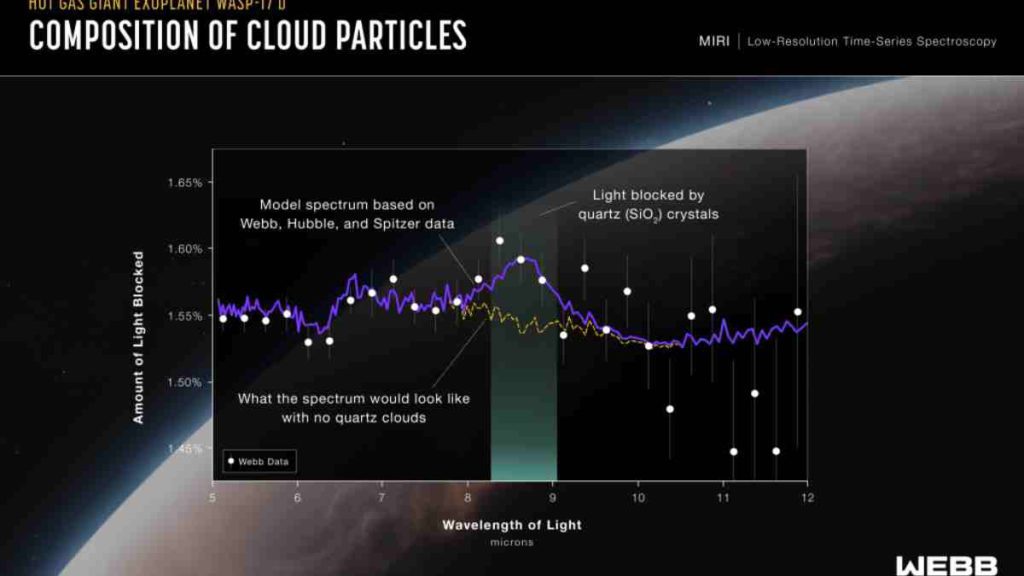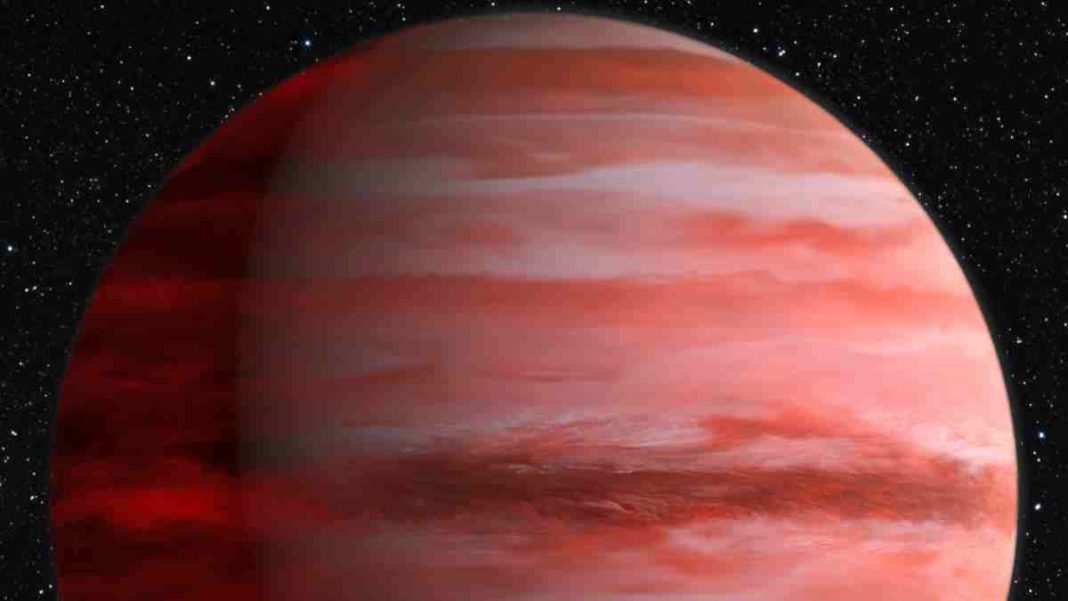UNITED STATES: NASA’s James Webb Space Telescope has uncovered evidence of tiny quartz crystals in the high-altitude clouds of WASP-17 b, a scorching hot Jupiter exoplanet located 1,300 light-years from Earth.
This revelation, made possible by Webb’s Mid-Infrared Instrument (MIRI), marks the first-ever detection of silica (SiO2) particles within an exoplanet’s atmosphere.
The revelation has left scientists thrilled and intrigued by the unexpected finding. “We were thrilled! We knew from Hubble observations that there must be aerosols—tiny particles making up clouds or haze—in WASP-17 b’s atmosphere, but we didn’t expect them to be made of quartz,” said David Grant, a researcher at the University of Bristol in the UK and the first author of a paper published in the Astrophysical Journal Letters.

This discovery challenges previous assumptions about the composition of exoplanetary clouds.
While silicates, minerals rich in silicon and oxygen, are abundant across the galaxy, previous observations of exoplanets and brown dwarfs indicated that silicate grains in their atmospheres were composed of magnesium-rich silicates like olivine and pyroxene.
However, in WASP-17 b’s atmosphere, researchers found quartz crystals consisting of pure SiO2.
Hannah Wakeford, a co-author of the study, noted, “We fully expected to see magnesium silicates, but what we’re seeing instead are likely the building blocks of those, the tiny ‘seed’ particles needed to form the larger silicate grains we detect in cooler exoplanets and brown dwarfs.”
The detection was made possible due to the unique capabilities of the James Webb Space Telescope. WASP-17 b is one of the largest known exoplanets, with a volume over seven times that of Jupiter and a mass less than half of Jupiter.
This, coupled with its short orbital period of just 3.7 Earth days, made it an ideal candidate for transmission spectroscopy, a technique that measures how a planet’s atmosphere affects starlight.
Webb observed the WASP-17 system for nearly ten hours, collecting over 1,275 brightness measurements of mid-infrared light in the 5- to 12-micron range as the planet transited its star.
By carefully subtracting the brightness of individual wavelengths of light when the planet was in front of the star from those of the star alone, the team calculated the amount of each wavelength blocked by the planet’s atmosphere. Their analysis revealed an unexpected “bump” at 8.6 microns, aligning with the presence of quartz.
The quartz crystals in WASP-17 b’s clouds are remarkably small, measuring just about 10 nanometers across, and they differ from mineral particles found in Earth’s clouds.
On this scorching exoplanet, where temperatures reach around 1,500 degrees Celsius (2,700°F) and pressures are much lower than on Earth, solid crystals can form directly from gas without going through a liquid phase.
This discovery not only expands our understanding of exoplanetary clouds but also sheds light on the planet’s composition.
WASP-17 b primarily consists of hydrogen and helium, with trace amounts of other gases such as water vapor (H2O) and carbon dioxide (CO2).
The presence of silica crystals like quartz suggests an additional source of oxygen in the planet’s atmosphere that had previously been overlooked.
While the exact quantity of quartz in the clouds and their distribution remains uncertain, it is believed that the clouds are likely to be present along the day/night transition region of the planet.
As WASP-17 b is tidally locked with a hot day side and a cooler night side, the clouds may circulate around the planet and vaporize when they reach the scorching day side.
WASP-17 b is one of three planets selected for study by the James Webb Space Telescope’s Deep Reconnaissance of Exoplanet Atmospheres using Multi-instrument Spectroscopy (DREAMS) investigations.
These studies aim to provide comprehensive insights into different classes of exoplanetary atmospheres.
Also Read: James Webb Telescope Discovers Mysterious Jupiter-Sized Objects Drifting in Space



